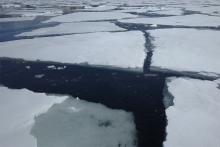The Southern Ocean surrounding Antarctica is a region where many of the world’s carbon-rich deep waters can rise back up to the surface. Scientists have thought that the vast swaths of sea ice around Antarctica can act as a lid for upwelling carbon, preventing the gas from breaking through the ocean’s surface and returning to the atmosphere.
However, researchers at MIT have now identified a counteracting effect that suggests Antarctic sea ice may not be as powerful a control on the global carbon cycle as scientists had suspected.
In a study published in the August issue of the journal Global Biogeochemical Cycles, the team has found that indeed, sea ice in the Southern Ocean can act as a physical barrier for upwelling carbon. But it can also act as a shade, blocking sunlight from reaching the surface ocean. Sunlight is essential for phytosynthesis, the process by which phytoplankton and other ocean microbes take up carbon from the atmosphere to grow.
The researchers found that when sea ice blocks sunlight, biological activity — and the amount of carbon that microbes can sequester from the atmosphere — decreases significantly. And surprisingly, this shading effect is almost equal and opposite to that of sea ice’s capping effect. Taken together, both effects essentially cancel each other out.
Link to article:



